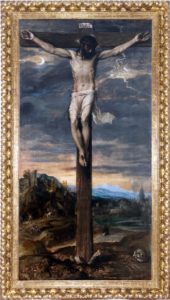 A painting of the Crucifixion by Old Master Titian was seriously damaged in a fall at the 16th century royal complex of El Escorial near Madrid in central Spain. The 8 x 4.5-foot oil-on-canvas Christ Crucified was discovered by security personnel around 10:00 AM on Wednesday, October 3rd, in the sacristy of the Monastery of San Lorenzo de El Escorial. It had become detached from the wall and struck the 16th/17th century furniture underneath it before bouncing onto the marble floor. The accident caused a considerable horizontal 7-shaped tear in the canvas across the lower portion of the painting.
A painting of the Crucifixion by Old Master Titian was seriously damaged in a fall at the 16th century royal complex of El Escorial near Madrid in central Spain. The 8 x 4.5-foot oil-on-canvas Christ Crucified was discovered by security personnel around 10:00 AM on Wednesday, October 3rd, in the sacristy of the Monastery of San Lorenzo de El Escorial. It had become detached from the wall and struck the 16th/17th century furniture underneath it before bouncing onto the marble floor. The accident caused a considerable horizontal 7-shaped tear in the canvas across the lower portion of the painting.
Experts from Spain’s National Patrimony, the public institution responsible for the management of property of the State that was formerly property of the Crown, were immediately dispatched to examine the masterpiece, assess its condition, come up with a repair plan and determine if possible the cause of the fall. They found that detachment was likely caused by the degradation of the plaster layer on the wall to which the painting had been anchored. Over the years the plaster that held the nails of the mount had gradually crumbled without anybody realizing what was happening. The tipping point came the night of October 2/3 and down came the painting.
Officials are quick to reassure that the figure of Christ himself was not torn. The entire pictorial layer appears to have been spare from any paint loss. The work has been protectively wrapped and packaged for transport to the central National Patrimony workshop in Madrid. There it will be analyzed thoroughly, treated and repaired to ensure its stability. When the restoration is done, the painting will be returned to the Royal Monastery of San Lorenzo, presumably, one hopes, in a new location.
Crucified Christ entered the Escorial collection in 1574, added by King Philip II who was an unabashed Titian fan and commissioned almost all of Titian’s outlay in the last 25 years of his life (from 1550 until his death in 1576). It’s not known exactly when Titian painted it. Stylistically it dates to the beginning of his late period characterized by experimentation with daring chiaroscuro night scenes and flesh tones, probably around 1555. It was already on its way to Philip II in 1556.
I sincerely hope that any other paintings mounted on the walls have been removed in order to inspect for degradation throughout the structure. Having another masterpiece fall and damaged would be disastrous.